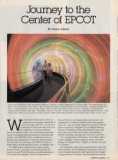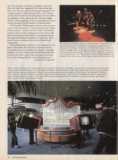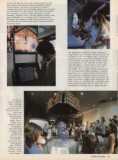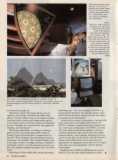Walter Elias Disney had a vision: an experimental prototype community of tomorrow (aka, EPCOT). 'It will be a community of tomorrow that will never be completed," he theorized shortly before his death in 1966, "but will always be introducing and testing and demonstrating new materials and systems. And EPCOT will be a showcase for the ingenuity and imagination of American free enterprise." Last October, 16 years later, the EPCOT Center of Walt Disney World opened its doors in Orlando, Fla.
The $800 million Center has two basic themes: Future World, a constantly evolving blueprint for tomorrow, and World Showcase, a global panorama with world's fair panache. One of the pavilions in Future World is the Kodak-sponsored Journey into Imagination. Computer hobbyists and artful gamers take note — the area titled Image Works allows EPCOT guests to paint by computers (on the Magic Palette), conduct a symphony (Electronic Philharmonic), and star in any one of three short films (Dreamfinder's School of Drama), among other interactive activities.
"It's a playground of the future," crows Barry Braverman, manager of show design at Disney and chief designer of Image Works. "A place to stretch your creative muscles."
[img]Guests enter the Sensor Maze through the Rainbow Corridor, a tunnel brightened by 150 neon tubes. The tunnel assigns each person one of five colors which follows them through the exhibit creating the effect, notes Braverman, of people "pushing rainbows." Following the Corridor is Image Warp, which contains mylar mirrors that have been stretched over loudspeakers, vibrated and hit with a strobe light. "Essentially, what it is." he says, "is an electronic version of the old funhouse mirrors." Also in the Sensor Maze is a voice-activated light sculpture called Lumia that responds to the frequency and volume of your voice.[/img]
For inspiration, Braverman reached back to the '60s, when sculptors were bringing new meaning to their art form through interactivity and high-tech artists began toying with lasers. In either case, participation was the key. For example, the idea for Stepping Tones (see photo at right) was suggested by art pieces that had been done 20 years ago in which people changed environments as they walked through them. Also, the pin screens, devices that can be manipulated to form different qualities of lines, which are also found in Image Works, were designed by Ward Fleming and first exhibited years ago in San Francisco's Exploratorium.
The Electronic Philharmonic, however, has its roots strictly in entertainment. "The idea for that one," Braverman explains, "came from Jerry Lewis' old comedy routines when he'd be sweeping up in the concert hall after a performance and couldn't resist getting up on the stage, pretending to conduct the musicians. They weren't there, of course, but you'd still hear all the instruments.
"Most people think that they're not imaginative," he adds. "They think that only a few select people are. Our belief is that everyone has the capacity, especially children. If we can learn to unlock (our imaginations), we'll see the world in new ways and really enrich our lives. That is Image Works' overreaching purpose."
[img]One of the most popular features in Image Works is Stepping Tones. Guests make music by stepping on the geometric shapes and colors that are set in the floor of the room. The electronic notes, which are stored on digital chips, are grouped according to type such as percussion, string and vocal sounds. "They're all very electronic yet harmonious in composition, "says Braverman. "People walking and Jumping around in this room create an electronic symphony that is all in tune. "[/img]
[img]Sperry-Univac's Compute-A-Coaster game, like others found in the Epcot Computer Central foyer, is a business-oriented computer game that demonstrates how data processing technologies aid the business world. In this game, which shows how a computer-assisted design system works, girders and other structural elements of a roller coaster ride flash on a color terminal. The player selects elements and places them in sequence, using a touch-sensitive screen. The system then displays the player's design, inserting such requirements as support struts and tracks and some background color, including skies and mountains, and, finally, a rider's eye view of the roller coaster's course.[/img]
[img]Lost For Words, one of the video computer games in Bell Labs' Future Com, demonstrates the company's isolated word recognizer. The object of the game is to guide a computer-generated mouse through a random maze by speaking commands into a microphone. The computer recognizes five commands – up, down, right, left and go — in seven languages — English, French, German, Spanish, Italian, Japanese and Russian. In a technique called "Dynamic Time Warping," the computer compares the pattern of the spoken word with the word patterns previously stored and chooses the closest match.[/img]
[img]The inspiration behind the 14 Magic Pallettes in Image Works came from the telestrators used by TV newsmen to write over weather maps. Visitors can unleash the artist within them by dipping into electronic inks and "drawing" on video screens with a pressure-sensitive stylus. There are 16 colors and eight line shapes to choose from, as well as three pictures for those who just want to color. Says Braverman: "We recognized that the ultimate creative tool is probably a pencil and paper or pallette and canvas, but we also recognized that we had to be clever about limiting the amounts of choices of activities because we couldn't have people there for three or four hours trying to paint masterpieces. We tried to come up with things that would yield results pretty quickly and easily and yet still he able to be manipulated in different ways by different people."[/img]
[img]You'll know you're in Sperry-Univac's interactive area when you come face-to-face with SMRT-I, a life-sized robot which plays guessing games with EPCOT guests. Participants choose numbers or animals displayed above the robot and then, using headphones, respond to the yes-or-no questions SMRT-I poses. After some clever calculations. SMRT-l delivers a correct answer — unless, of course, "it does not compute."[/img]
[img]There are four larger than life (3 ft. x 3 ft. 3 ft.) kaleidoscopes inside Image Works. As in the smaller versions, these utilize mirrors. Unlike those, however, these are operated with handlebars.[/img]
[img]Below:
Bell Labs' Chip Cruiser is an Interactive Electronic Display that illustrates some of the hazards involved in the manufacture of silicon chips. The player must protect the surface of his chip from particles such as dust, hair, and water vapor by zapping them with a laser cannon. In order to protect the chip from static electricity, the player must press another button which sets up a shield.[/img]
[img]The Journey Into Imagination pavilion as it appears by day. To house this "creative playground of the future," the architects chose two pyramid-shaped crystal structures, giving it a "high-tech" cathedral feeling.[/img]
Braverman realizes that Image Works may not appeal to the average, hooked-on-Pac-Man video gamer. "I'd like to believe that, in the long run, people would get tired of shooting at things and be open to more creative types of activities using new technology," he says. "Perhaps, this is the direction video games are heading — but who knows?"
Braverman, meanwhile, is working on prototype games for the Tron arcade that will be housed in another Future World pavilion, CommuniCore, by late-'84. "We're looking at the same thing everyone is looking at," he concedes. "More realistic displays, different audio systems, 3-D flight simulators. Instead of looking at a screen, you walk along the projection surface, for example, and play the games with your whole body."
Working for Disney offers him a unique advantage, Braverman says. "We can do things in EPCOT in a one-of-a-kind speculative way that the industry can't do for obvious economic reasons. We also don't have to compete in the marketplace."
CommuniCore already invites guests to interact with some of the latest technological achievements. In EPCOT Computer Central, sponsored by Sperry Univac, visitors can communicate with SMRT-1 (a robot, who plays question-and-answer games), construct a computer-generated roller coaster and, from a glass-enclosed balcony, view computer technicians at work on the systems that run the Center. And Bell System's Future Com exhibit allows you to learn about the manufacture of integrated circuits and travel through a video maze via vocal commands — both by playing actual games.
Hopefully this VIDEO GAMES pictorial tour of EPCOT is the next best thing to getting you there.



